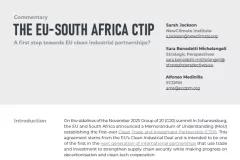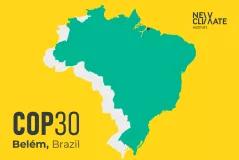Briefing, 11 February 2015
Niklas Höhne (NewClimate Institute), Michel den Elzen (PBL Netherlands Environmental Assessment Agency), Annemiek Admiraal (PBL)
This briefing provides an overview on the feasibility and implications of phasing out net global greenhouse gas emissions. It was prepared in the framework of the ACT 2015 project.
What is meant with “net phase out of greenhouse gas (GHG) emissions”?
Net phase out of GHG emissions means that anthropogenic emissions[1] of greenhouse gases to the atmosphere decrease to a level equal to or smaller than anthropogenic removals of greenhouse gases from the atmosphere. This would require that emissions from energy, industry, agriculture, forestry and waste are reduced to a bare minimum and compensated by emission removals from e.g. forests and carbon capture and storage (CCS).
What is meant with “climate neutrality” or “carbon neutrality”?
“Climate neutrality” on the global scale is equivalent to the net phase out of greenhouse gas emissions. Remaining GHG emissions are compensated by at least the same amount of uptake (negative emissions) so that the net input of greenhouse gases to the atmosphere due to human activities is equal to or smaller than zero.
“Carbon neutrality” is a very similar concept, but for carbon dioxide (CO2) emissions only, as used by IPCC AR5[2] and UNEP[3]. Global carbon neutrality means that annual anthropogenic CO2 emissions are net zero on the global scale.
If applied on a smaller scale (country, city or company), climate or carbon neutrality would include offsets / emission reductions from other activities outside of the boundary.
How does the global carbon budget relate to phase out of GHG emissions?
Carbon budget = eventually net zero CO2 emissions: The climate science working group of the IPCC re-emphasized the carbon budget concept: stabilization of the global temperatures at a specific level requires that the amount of CO2 emissions in the future is limited (the carbon budget). This means in turn that if the budget is depleted, net CO2 emissions have to be zero. The lower the final desired temperature increase, the earlier CO2 emissions have to be zero. The scenarios used in the IPCC report also assume reductions of the other greenhouse gases of to a similar extent than CO2.
Do we need net negative emissions after emissions have been phased out to net zero?
If the carbon budget is overspent, global emissions have to become net negative to make up for the overspending. The only technological option currently assumed in models to remove CO2 permanently from the atmosphere is the use of biomass with carbon capture and storage. This technology has not yet been tested on a large scale and may face social acceptance risks.
How does a 100% renewable energy target relate to phase out of GHG emissions?
100% renewable energy is a way to achieve the global phase out of energy-related CO2 emissions. An energy system based on 100% sustainably sourced renewable energy would mean zero energy related CO2 emissions. In fact, some of the 2°C compatible scenarios arrive at a global energy system that is entirely based on renewable energy. The concept of a net phase out of GHG emissions is larger in scope than a 100% renewable target; it includes also non-energy related emissions, such as CO2 from forestry and non-CO2 emissions from industry, agriculture and land use and would also allow use of fossil fuels with carbon capture and storage.
When do global GHG emissions have to be phased out to be compatible with 2°C?
The phase out year depends on (a) the likelihood with which 2°C is to be met, (b) whether one considers all greenhouse gases or only CO2 emissions and (c) when reductions are assumed to start. Based on the scenarios from the IPCC Fifth Assessment Report global phase out dates are provided in Figure 1.
- For a likely chance of meeting the 2°C target, global emissions of all greenhouse gases need to be net zero at least by 2100: The working group III of the IPCC covering options to reduce GHG emissions has analysed hundreds of modelled scenarios of future emissions (IPCC WGIII AR5 scenario database). The working group shows that, in scenarios with a 66% likelihood of keeping the temperature increase below 2°C, global GHG emissions are roughly zero in 2100. The full range is 18% below zero to 22% above zero (as a percentage of 2010 emissions) (Table SPM.1).
- For a likely chance of meeting the 2°C target, global CO2 emissions need to be net zero around 2070 (Figure 6.4): In general, most scenarios assume that CO2 and non-CO2 emissions are reduced with about the same effort. Most scenarios assume that options to reduce emissions of N2O and CH4 from agriculture and land use to zero are not readily available; therefore the residual emissions will be compensated for by net negative CO2 emissions after total net zero GHG emissions are achieved. As a result, the phase out date for CO2 is somewhat earlier than that for all GHGs.[4]
UNEP (2014) has analysed the impact of starting reductions in 2020 instead of 2010 (the default assumption). More specifically, they analysed two subsets of scenarios in the IPCC AR5 scenario database: (i) scenarios with limited action until 2020 and costs-optimal mitigation afterwards, and (ii) scenarios with costs-optimal mitigation from 2010 onwards. Their analysis showed:
- The higher the emissions in the near-term, the higher the level of negative emissions, and the earlier the timing of reaching zero emissions. For scenarios starting reductions only in 2020, the global GHG emissions need to be zero by 2080, and for CO2 emissions by 2065. This is about twenty (all greenhouse gases) and five years (CO2) earlier compared to the dates under the least-costs 2010 scenarios.
The Climate Action Tracker team has used the IPCC scenario database to assess only scenarios that have a high chance (a 85% likelihood) of meeting 2°C to implement the precautionary principle. [5] Their analysis showed:
- For a high chance of meeting the 2°C target, global emissions of all greenhouse gases would need to be net zero between 2060 and 2080 and likely negative thereafter. Under these conditions emissions have to be net zero earlier.
- For a high chance of meeting the 2°C target, global CO2 emissions from fossil fuel combustion and industry would need to be zero between as early as 2045 and no later than 2065, and be negative thereafter. The Climate Action Tracker separated CO2 emissions from fossil fuels and industry, which are assumed to be phased out earlier. For a high certainty of meeting 2°C, phase out of these emissions must occur by the middle of the century.
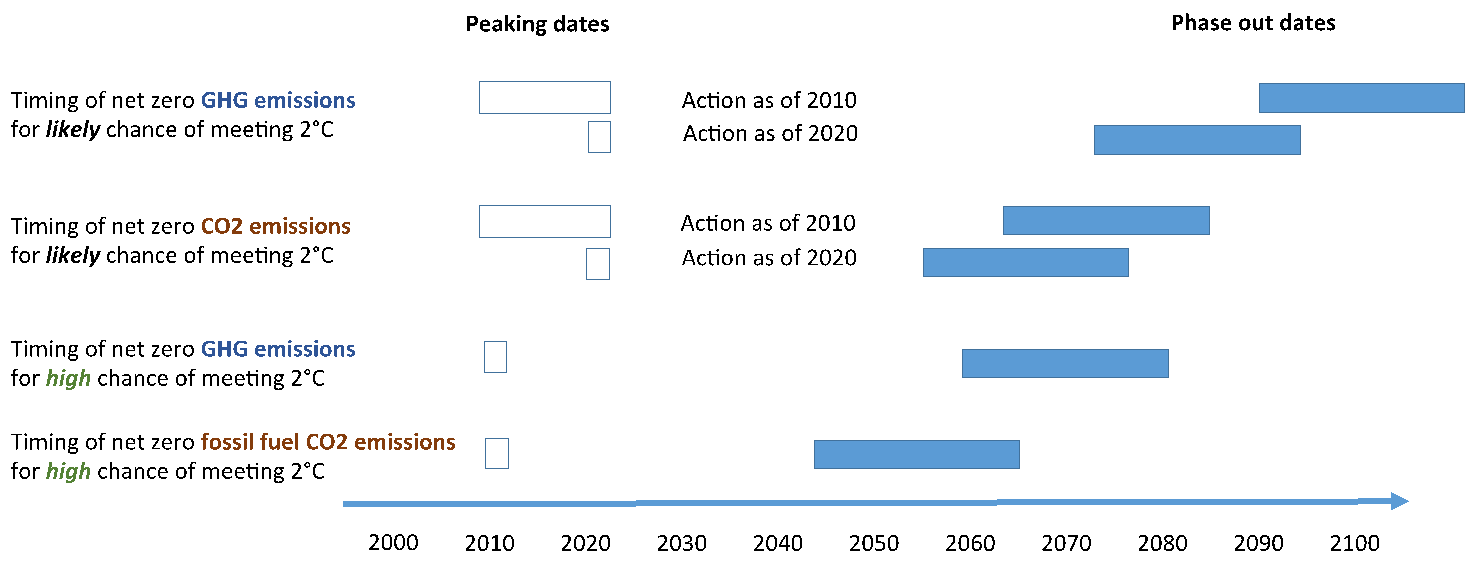
Figure 1: Timing of global peaking and global phase out of greenhouse gas emissions based on the IPCC emission scenarios
Are the technologies available to phase out global greenhouse gas emissions?
The scenario model runs used in the IPCC report use a suite of technologies to achieve low global emissions. The model runs put different emphasis on the different options. In fact, the models have the choice between different options.
Technological options are available already today and in the near future for roughly 90% of current sources of GHG emissions[6]. Complete phase out of also the remaining 10% by the middle of the century could be achieved with technological innovation and offsetting residual emissions. As a last resort exemptions for “essential uses” could be applied. Table 1 provides an overview of the current sectoral emissions, options to phase out greenhouse gas emissions and remaining challenges, based on the work of Höhne et al. 2013.
| Sector | Current emissions (% of global total) | Main areas where technological options are available today or in the near future to reduce GHG emissions | Remaining technical challenges |
| Industry | 29% | Material and energy efficiency; fuel switch to electrification and sustainably source biofuels; CCS; no HFCs | No technical option currently available for some production processes (currently 6% of global emissions) |
| Buildings | 18% | Zero emissions buildings (new and renovated); efficient appliances | Energy efficient renovation of existing building stock |
| Transport | 15% | Smart urban areas, energy efficiency; modal shift to public transport and electric rail; electric and hybrid vehicles; sustainably sourced biofuels | Shifting to 100% biofuel use in air, water and freight road transport; extending range of electric vehicles |
| Energy supply | 13%* | Renewable energy, nuclear; CSS; methane capture and re-use in fossil fuel production | Dependency on viability and infrastructure needs of CCS (some scenarios); integration of renewables in the electric grid |
| Land use change | 15% | Stopping deforestation/degradation; afforestation and reforestation | Conflicting demands for land |
| Agriculture | 7% | Adoption of improved livestock and agricultural land managemtn technologies and practices; reduction of demand through reduced food wastage and dietary changes | Existing abatement options provide some emissions reduction but not to zero |
| Waste | 3% | Stopping organic waste landfilling; treating waste water | - |
|
Table 1: Current global emissions, options for phasing out emissions and remaining technical challenges *The share of energy supply does not include electricity and district heat used in the industry / buildings / transport sectors. These emissions are included in those sectors. Source: Höhne et al. 2013, Feasibility of GHG emissions phase-out by mid-century, http://www.ecofys.com/files/files/ecofys-2013-feasibility-ghg-phase-out-2050.pdf |
|||
Is nuclear power needed for global phase out of GHG emissions?
Some scenarios foresee a larger share of nuclear energy while other scenarios have a lower/zero share. Nuclear energy can be replaced by other sources of electricity, e.g. renewables. This is why the scenarios that by definition phase out nuclear power are only marginally more expensive than model runs without this constraint. For example, the IPCC WGIII AR5 (Table SPM.2)[7] shows an increase of around 7% in total costs for a scenario without nuclear relative to a full portfolio scenario with immediate action, and AMPERE study[8] finds an increase of around 25%.
To what extent is bio-energy needed for global phase out?
Bio-energy and changes in land use patterns is an important part of the solution mix. Biomass is currently the only sustainable energy source for fuels, e.g. for airplanes and trucks. It requires that this biomass is sourced sustainably and without compromising food security and other land demand. Scenarios show that this is possible, but that it needs to be very carefully managed. For example, the IPCC WGIII AR5 (Table SPM.2)[9] shows an increase of around 60% in total costs for a scenario with limited bio-energy relative to a full portfolio scenario with immediate action, and AMPERE study[10] found an increase of 100%. It should be noted that the number of models that find the 2°C target feasible decreases substantially when the use of bioenergy is limited.
Is a reduction in energy services or a reduction in consumption necessary for a global phase out of GHG emissions?
The usual assumption in the modeled scenarios is that consumption increases, primarily in developing countries with comparatively low consumption levels today. This means that consumption of energy services and food, in particular meat consumption, would increase. Changes in lifestyle of parts of the population with high consumption levels would provide for additional GHG emission reductions usually not included in the model runs.[11]
Is a net phase out of GHG emissions equitable?
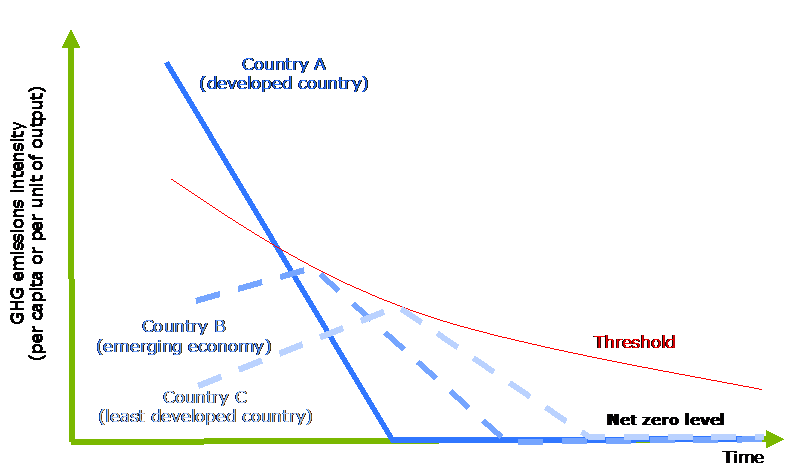
Figure 2: Illustrative differentiated phase out
Phase out of GHG emissions is ultimately necessary on the global level, so in all countries, but can be differentiated in timing. Some countries can phase out emissions earlier to make space for later phase out by other countries (Figure 2). Some countries will require support to achieve the phase out.
Additional work is underway to combine equity considerations with global phase out of greenhouse gas emissions. E.g. ODI published a report with a strategy to achieve zero extreme poverty and zero GHG emissions.[12] The Mary Robinson Foundation - Climate Justice (MRFCJ) also published on zero carbon zero poverty.[13] Track zero provided a business case for net phase out.[14]
What are particular technical challenges with a global net phase out?
A step change in global action is needed. The scenarios underlying the feasibility assume a rapid transition as soon as possible in almost all countries.
Foresight is needed. The technical solutions for phase out of greenhouse gas emissions require changes in long lasting infrastructure, such as power plants, energy systems, buildings and transport infrastructure. These long-term investments need to be carefully managed. Foresight in clear, long term policies is needed here to realize these investments.
Removal of emissions from the atmosphere needed. Greenhouse gases will also have to be removed from the atmosphere to compensate for remaining emissions that cannot be reduced and to compensate for delay of action. Current technological solutions may require more technical maturity and social acceptance, such as carbon capture and storage, or may face other constraints, such as forestry and demand for land.
Annex
Annex
The carbon budget concept is illustrated for the global emission pathways of the 900 mitigation scenarios, as collected in the IPCC WGIII AR5 scenario database, shown in Figure SPM.4 of IPCC 2014 WGIII AR5 Summary for Policy Makers (SPM) (here Figure 3). The range spans atmospheric concentration levels of 430 ppm CO2eq to above 720 ppm CO2eq in 2100, which is comparable to the 2100 forcing levels between Representative Concentration Pathway (RCP) 2.6 and RCP 6.0. Figure 4 shows that the cumulative emissions of CO2 from 1870 to 2100 (carbon budget) resulting from these scenarios largely determine global mean surface warming by the late 21st century and beyond (IPCC 2014 Synthesis Report[15] Figure SPM.10).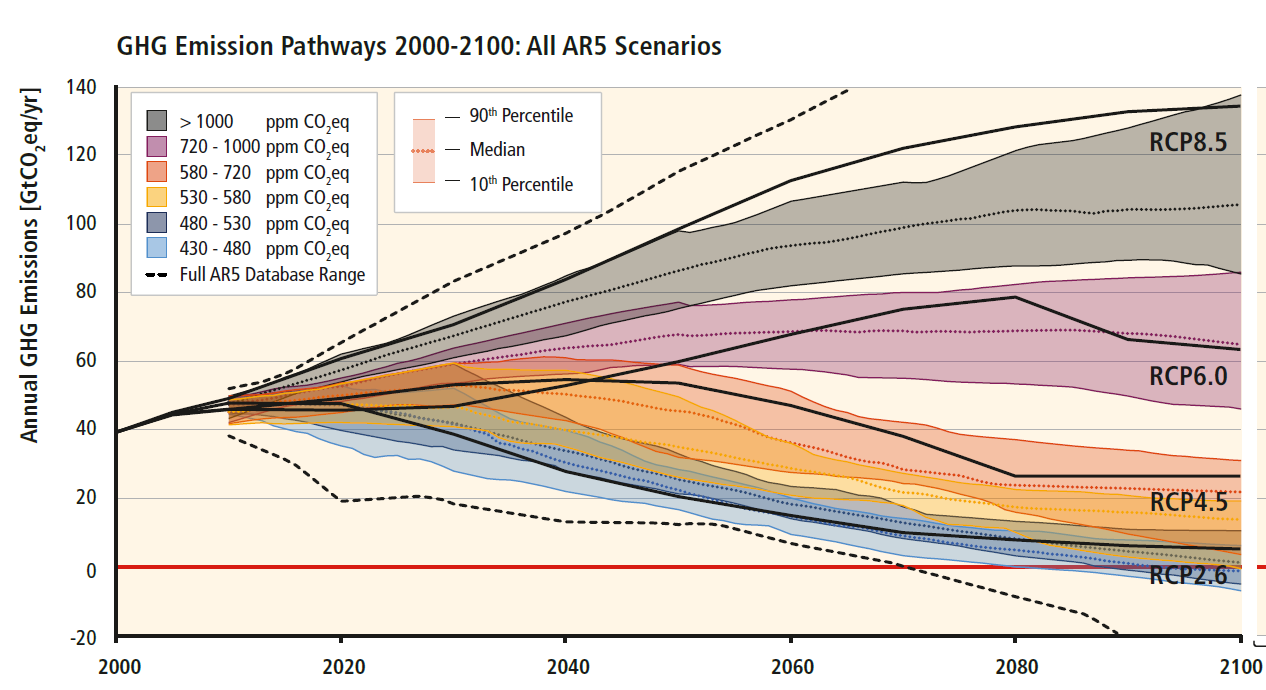
Figure 3. Pathways of global GHG emissions (GtCO2eq/yr) in baseline and mitigation scenarios of all IPCC AR5 scenarios (including the RCPs) for different long-term concentration levels. Source: IPCC 2014 WGIII Report (Figure SPM.4)



